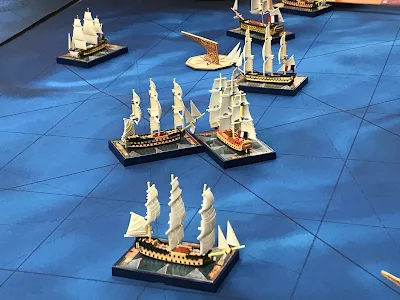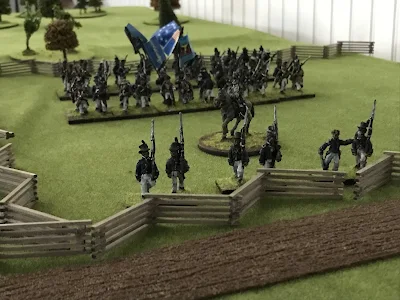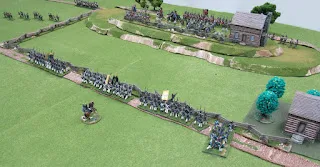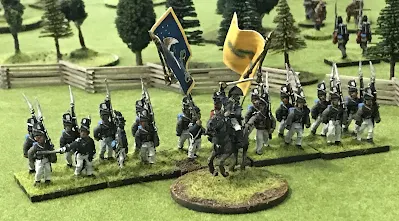Today is the anniversary of the Battle of Chippewa on 5 July 1814. This was the battle which sparked my interest in the War of 1812 when we visited the battlefield in 1985 (and again in 2018). Although minor in terms of numbers the battle is important in the rebuilding of the American army during the War of 1812. General Winfield Scott's trained brigade is able to stand toe to toe with British regulars. The brigades gray jackets becomes the stuff of legend in the history of the American regular army.
To me its one of the perfect battles to fight on the table top. It has simple terrain, balanced and equal units and colorful uniforms. British regulars in red coats, gray jacketed Americans regulars, volunteers in mixed dress and native Indians. You would have a most difficult time finding a more perfect battle to fight in miniature.
For this battle I used the maps out of Richard Feltoe's book, "Tides of War." I concentrate the area in the center between the two fence lines for my table. To fit the battlefield on a six foot by five foot table I divided the field in half to represent the plain and the woods. Fences outlined the woods and defined the roads. This way I could place trees in the wooded area but players could move the trees to not interfere with troop movement. I did not include either river. Instead both sides had to enter the table on the road in road column. The British/Canadian forces enter at top if map while Americans enter from bottom of map.
Light troops for both sides were already deployed in the woods. Historically I should have had the players in the woods fight for three or more turns before the regulars entered the table. But I did not want players just hanging around doing nothing ( no fun there). So for the first couple turns players commanding the regulars entered the table and deployed while the light troops fought it out in the woods. Rules used for the game were Steve Haller's "Whites of their Eyes."
American Order of Battle:
Brig.General W. Scott
9/21st Regiment (24 figures)
11th regiment. (24 figures)
25th regiment (24 figures) (elite)
Towson's battery (1 gun)
Brig.General Porter
Pennsylvania Volunteers (24 figures)
Red Jackets Six Nation Warriors ( 2 x 10 figures each)
British/Canadian forces:
General P. Riall
1st Regiment of Foot. (24 figures)
8th Regiment of Foot. (24 figures)
100th Regiment of Foot. (24 figures)
Royal Artillery. (1 gun)
Lt.Col. Thomas Pearson
Light companies (12 figures)
Lincoln Militia. (12 figures)
Norton's warriors. (8 figures)
Western Lakes warriors (10 figures)
The Battle:
The regulars from both sides marched onto the cleared area (called "the plain" by both sides). The Infantry in column and deployed into line while the artillery quickly set up and got the range.
The light troops approached each other in the woods with the native warriors leading both columns. Red Jacket's Six Nations warriors pushed back their counter parts while the Pennsylvania volunteers made short work of the Lincoln militia.
Captain John Norton rallied his native warriors and returned to the fight. More importantly the combined British light infantry companies (1st, 8th and 100th) under Lt.Col. Pearson entered the fight. Attacking the Pennsylvania volunteers they routed them and killed General Porter.
On the plain while this was going on General Scott deployed his Brigade with Captain Towson's Artillery on his right flank. General Riall with slightly less room deployed the 1st and 100th in line with the 8th in reserve. The Royal Artillery under Captain Armstrong also deployed along the road. But as his infantry advanced they blocked his field of fire.
Once there was enough room the 8th Regiment moved into line with the other regiments. Scott moved the 25th US Infantry up to face them with the 9th/11th US Infantry opposite the 1st Regiment and the 22nd US Infantry opposite the 100th Regiment. During this time both sides artillery continued a long range fire in the advancing infantry causing very few casualties.
For the next two moves the both sides exchanged musket and artillery fire. All regiments stood firm in spite of casualties.
Hoping to break the deadlock, Scott ordered the 25th US Infantry to charge the 8th Regiment. In the melee that followed the 8th (having suffered heavy casualties already) fell back and then failed its morale test.
With his line out flanked Riall quickly ordered his artillery to limber up and retire while his infantry grimly fell back. Although Pearson in the woods had finally driven off the enemy warriors he was too late to help the regulars.
Conclusion:
A fun little game which mirrored the historical battle. I think if the British/Canadian lights in the woods could have returned sooner they might have effected the main battle. As it was I was surprised how easily the British light infantry drove off their enemies; especially the militia. For the British/Canadian commander it takes some time to bring his regulars into line which lets the American get a few extra hits on him.
All in all the rules worked very well. I usually use these for my Rev War games but with some slight modification worked well here. With rules in think its important to have a set you play regularly so you know and understand them. Changing rule sets at the drop of a hat is not my thing and effects the game negatively.
Thank you for staying with me on this. If any of you try this game out I would like to hear about it. I will be putting g thus game on again at the end of the month for my club. Lets see if history gets changed then.



















.jpeg)





















